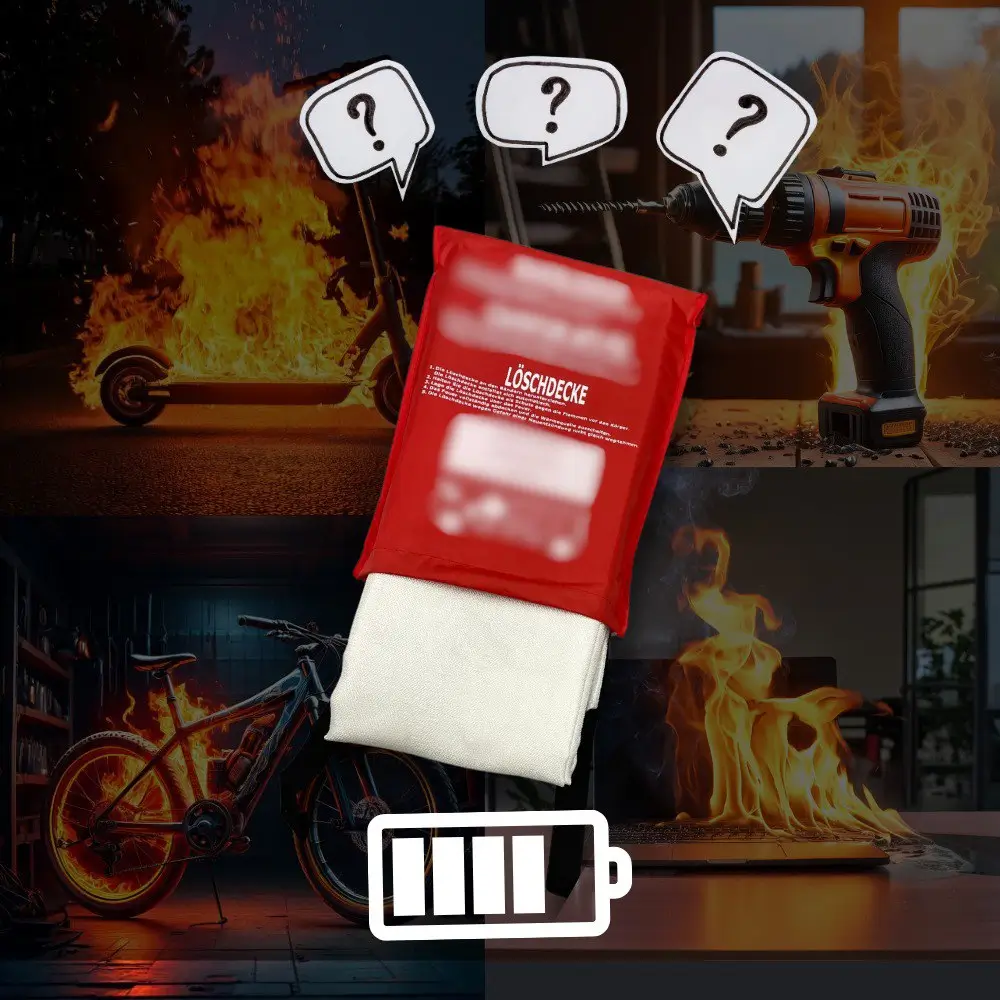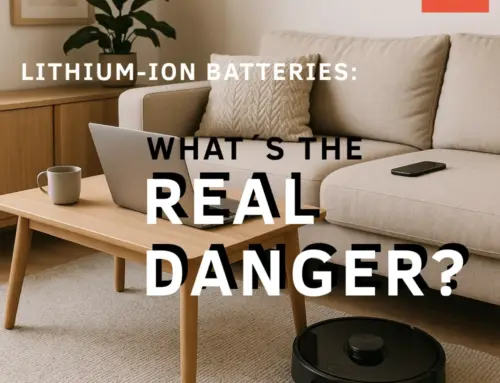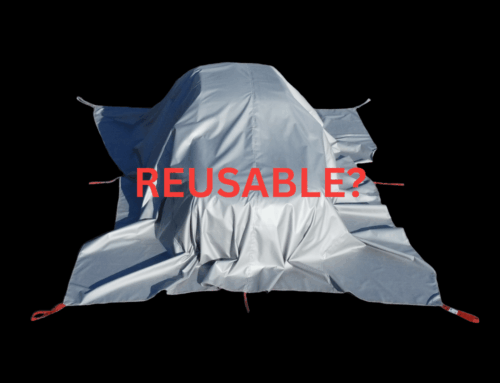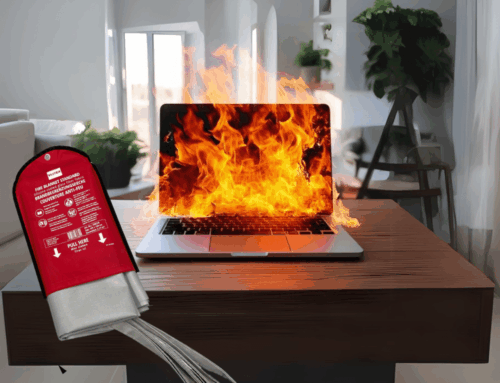
Lithium-ion batteries are installed in many modern devices and vehicles. They provide an efficient energy supply, but pose considerable risks in the event of a fire. Many people resort to conventional Fire blankets in such situations, as they are known as a quick and easy solution from other fire scenarios. But this is precisely the problem: Fire blankets are completely ineffective in battery fires and do not offer sufficient protection.
In this article, you will find out why classic Fire blankets cannot stop battery fires, where their limits lie and which alternatives really protect.
Table of contents
How do conventional Fire blankets work?
Fire blankets have been developed for classic fires. They are usually made of non-combustible fiberglass or aramid fabric and work according to a simple principle: they smother the fire by depriving it of oxygen.
This principle is particularly effective for:
- Grease fires in the kitchen
- Burning textiles or paper
- Incipient fires in households, offices or commercial enterprises
- Fires in electrical devices such as multiple sockets
However, while this method works reliably for conventional fires, it does not work for battery fires - for several reasons.
Why do conventional Fire blankets fail in battery fires?
Battery fires cannot be smothered
The biggest problem with a burning lithium-ion battery is that it has its own source of oxygen.
While a grease fire or a paper fire goes out as soon as it is deprived of oxygen, a burning battery releases its own combustible gases during the burning process. These contain enough oxygen to continue feeding the fire - even if a Fire blanket is placed over it.
This means that a conventional Fire blanket has no influence whatsoever on the chemical reaction inside the battery and cannot stop the fire.
Extremely high temperatures destroy conventional Fire blankets
A lithium-ion battery fire can reach temperatures of over 1,300 °C , while classic Fire blankets are only designed for temperatures of around 500 °C.
This means that a conventional Fire blanket:
- melt or crack due to the extreme heat,
- itself become combustible if it is not made of specially coated material,
- simply not be able to contain the fire.
In many cases, this means that a Fire blanket not only remains ineffective, but also destroys itself and therefore no longer offers any protection.
Explosive reactions and highly toxic fumes
Another problem with battery fires is the risk of explosive reactions. The individual cells in the battery can burst due to the high heat development and eject burning fragments into the environment.
In addition, a battery fire releases highly toxic gases such as hydrogen fluoride. Even small amounts of these can cause serious damage to health. A conventional Fire blanket cannot contain these gases, allowing the toxic vapors to escape unhindered.
Battery fires can re-ignite after hours or days
Another problem with lithium-ion fires is the high probability of re-ignition.
Even if the fire appears to have been brought under control, the heat stored in the deeper cell layers of the battery can continue to build up for hours or even days. This can lead to the battery spontaneously re-igniting if no suitable measures are taken.
A conventional Fire blanket cannot prevent this problem as it does not provide long-term insulation against the heat stored in the battery.
What is the alternative? - fire blankets
As conventional Fire blankets fail in the event of lithium-ion battery fires, special fire blankets have been developed. These are designed to withstand the extreme temperatures and minimize the risk of battery fires.
fire blankets - The better choice for battery fires
Heat resistance up to 1,750 °C
fire blankets are made of high-temperature resistant material such as silicone-coated glass fiber or silica fabric. While a conventional Fire blanket can be destroyed by a battery fire, a fire blanket remains intact and protects the surroundings.
Containment instead of extinguishing
As a battery fire cannot be stopped by removing oxygen, fire blankets focus on containing the fire. They prevent the fire from spreading to neighboring objects, vehicles or buildings and reduce heat radiation and smoke development.
Protection against smoke gases and toxic fumes
Unlike conventional Fire blankets , fire blankets can contain the spread of toxic gases. This minimizes the danger to emergency personnel and bystanders.
Available in different sizes for different applications
fire blankets are available for a wide range of scenarios - from small models for laptops and e-bike batteries to large blankets for electric vehicles and electric forklift trucks.
If you want to protect yourself and your surroundings from the risks of a battery fire, you should therefore not rely on a classic Fire blanket , but use a specially developed fire blanket .
Why conventional Fire blankets offer no protection against battery fires
Fire blankets are a proven method of firefighting - but not for lithium-ion battery fires.
The principle of oxygen suppression does not work, the extreme temperatures destroy the blanket and toxic smoke gases can spread unhindered. There is also a risk of re-ignition, against which a classic Fire blanket offers no protection whatsoever.
The only effective solution for battery fires are fire blanketswhich have been specially developed for these challenges. They are heat-resistant, prevent the flames from spreading and minimize the risk for emergency personnel and bystanders.
If you really want to protect yourself, you should therefore not rely on a normal Fire blanket , but choose a tested fire blanket , which can of course also be used for conventional fires. See the difference between a Fire blanket and a fire blanket in our fire test with an e-scooter!
You can find more information on choosing the right fire blanket on the VLITEX product page.
For further scientific findings on the fire behavior of lithium-ion batteries, we recommend the Fraunhofer Institute Website.









